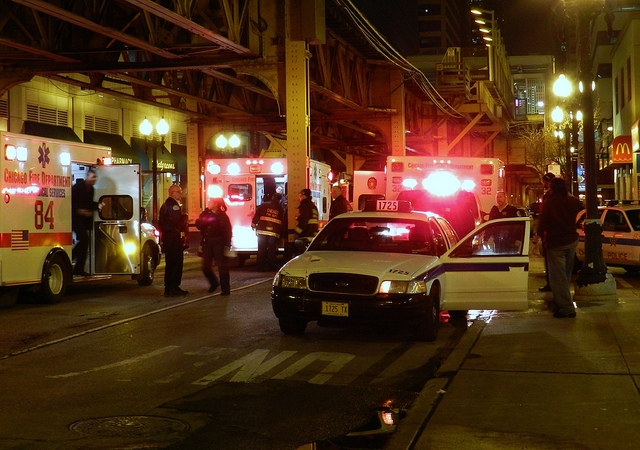Chicago Magazine Continues Expose Into CPDs Obsession (And Tinkering) With Crime Stats
By Chuck Sudo in News on May 20, 2014 3:00PM
Chicago magazine made waves last month with an investigation looking into Chicago Police Department’s obsession with crime statistics and how department brass may be playing with the numbers to give politicians and residents the perception of progress in fighting crime.
Reporters David Bernstein and Noah Isaacson are back with Part 2 of their series and the narrative they established in Part 1 only gets better. While Part 1 focused on the homicides statistics which receive the lion’s share of attention from media, Part 2 looks at the drop in the other index crimes reported to the FBI for its Uniform Crime Report.
According to Police Department data obtained by Chicago, burglaries are down 33 percent from 2010 through 2013; robberies are down 16 percent; aggravated batteries have decreased by 20 percent; and motor vehicle thefts have dropped 35 percent. Overall, index crime totals have decreased by an average of 19 percent annually from 2010 through 2013, which Bernstein and Isaacson write is “akin to a chronically mediocre student all of a sudden earning straight As.”
The numbers have criminologists and former police officers scratching their heads, especially knowing the budget constraints Police Superintendent Garry McCarthy and his brass face on a daily basis. According to Bernstein and Isaacson, two things have factored into this improvement, none more shocking to readers than this:
(M)any police sources say they have been pressured by superiors—explicitly and implicitly—to underreport crime. There are, according to an expert source on the department’s statistics, potentially “a million tiny ways to do it”—including misclassifying and downgrading offenses, counting multiple incidents as single events, and making it more difficult for people to report crimes or actively discouraging them from doing so.
This, according to one police lieutenant, is called “the washing machine” because “they wash and rinse the numbers.”
Bernstein and Isaacson write that since the first part of their investigation was published they’ve heard from current and former officers and victims of crimes to tell their stories. CPD spokesman Adam Collins, who right now has one of the most thankless jobs in Chicago PR, said the investigation’s allegations are “false, and built on information that is factually incorrect, misleading, and unsubstantiated.”
“We take the tracking, compiling, and reporting of crime data extremely seriously … and [it] is shared with the public to provide an accurate understanding of crime conditions.”
The investigation also theorizes the Police Department’s ongoing manpower shortage may be a contributing factor, as officers on the street are so taxed they can’t respond to every 911 call. And if a crime isn’t reported, did it happen? Bernstein and Isaacson continue to lay much of the blame for the alleged cooked books on CompStat, the system for tracking crimes which McCarthy learned while a member of the New York Police Department and brought to Chicago with him from Newark, NJ three years ago. CompStat has become the darling of police departments across the country and McCarthy’s predecessors at CPD implemented similar strategies, but nothing has produced the results seen in the past three years.
There’s precedent for skepticism of CompStat numbers.
In May 2010—four years after McCarthy left the NYPD to become the top cop in Newark, New Jersey—The Village Voice published excerpts of transcripts from hundreds of audio recordings of station house roll calls from 2008 and 2009 made by an officer in the 81st Precinct, in Brooklyn’s tough Bedford-Stuyvesant neighborhood. NYPD bosses were caught on tape pressuring street cops to downgrade crimes and discourage victims from reporting offenses, among other things, to bolster the precinct’s stats. An outside report ordered by former police commissioner Raymond Kelly would confirm that manipulation went well beyond one precinct and “may have an appreciable effect on certain reported crime rates.”In their 2012 book The Crime Numbers Game: Management by Manipulation, Silverman and John Eterno, a former NYPD captain who is now a professor of criminal justice at Molloy College in Rockville Centre, New York, describe how over time data-driven policing turned the NYPD to the dark side. “Initially, they started off with all the good intentions in the world, but then the political pressures and the pressures from the top became so great that they changed,” explains Eterno. “When the pressure comes from the political powers, it is very difficult for honest working police officers to battle that.”
Bernstein and Isaacson even report CPD keeps two books of crime data. One book follows the FBI’s rules on counting index crimes. The other, in CompStat, is for CPD use only. A source told Chicago, “They collect whatever data they want, they use it however they want to use it, and they don’t have to tell anybody [what data they’re collecting or how they’re doing the counting].”
